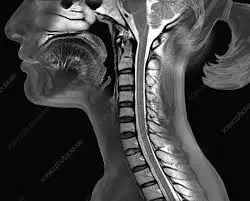頸椎MRIの解釈方法: 3つの重要な技術
頸椎MRIは、磁場とラジオ波を使用して首の領域の画像を作成する詳細なイメージング技術です。このガイドでは、頸椎MRIが何を示すか、なぜ使用されるか、そしてその結果をどのように解釈するかを説明します。
頸椎MRIとは?
頸椎MRIは、首の骨、椎間板、脊髄、軟部組織の詳細な画像を提供する非侵襲的な検査です。首や脊髄に関するさまざまな問題を診断するための強力なツールです。この技術が何を含み、何を明らかにするかを見ていきましょう。

頸椎MRIでは何が示されるか?
- 詳細な画像: 頸椎、椎間板、脊髄、および周囲の軟部組織の明確な視覚化。
- 椎間板異常: 頚椎ヘルニアや膨隆椎間板を検出し、首の痛みや神経圧迫を引き起こす可能性があります。
- 脊髄の問題: 脊髄に影響を与える状態(圧迫、炎症、腫瘍など)の特定。
- 靭帯および軟部組織の損傷: 首の軟部組織に影響を与える捻挫や筋肉の損傷の診断。
- 骨の異常: 脊椎骨の骨折、脱臼、腫瘍、または変性変化の検出。
- 神経圧迫: 神経が圧迫または刺激されている可能性のある領域を特定し、痛み、麻痺、または筋力低下を引き起こす。
なぜ頸椎MRIが必要か?
- 首の痛み: 特に腕に放射している場合、持続的な首の痛みの原因を調べるため。
- 麻痺や筋力低下: 腕や手の神経的な症状を調査するため。
- 脊髄の怪我が疑われる場合: 外傷や事故の後に脊髄への損傷を評価するため。
- 手術前の計画: 手術前に状態についての詳細情報を得るため。
- 既知の状態を監視: 脊椎管狭窄症、多発性硬化症、腫瘍などの状態の進行を追うため。
頸椎MRI結果の解釈方法
MRI結果を理解することは、効果的な健康管理にとって重要です。ここでは、結果の解釈を助けるいくつかの一般的な方法の概要を示します。
1. X-ray Interpreterを利用する
X-ray Interpreterは、MRI画像のAI駆動の分析を提供しています。次のように利用できます:
- 登録: X-ray Interpreterにサインアップして、MRI分析にAIを使用します。
- MRIのアップロード: 頸椎MRI画像をアップロードします。
- 解釈の確認: 詳細なレポートと共にAI生成の解釈を受け取ります。
- 相談: 完全な診断と治療計画のために、常に医師に相談してください。
詳細については、スタートガイドをご覧ください。
2. ChatGPT Plusを使用する
ChatGPT Plusは、進化したGPT-4Vモデルを用いてMRI画像を分析するのに役立ちます:
- サブスクリプション: 高度な機能のためにChatGPT Plusに登録します。
- MRIのアップロード: OpenAIプラットフォームにMRI画像をアップロードします。
- 分析のリクエスト: AIにMRI画像を解釈し、レポートを生成するように依頼します。
- 結果の確認と検証: 結果を確認し、医療提供者と一緒に正確性を検証します。
ChatGPT Plusを使用した医療画像の解釈については、ブログをご覧ください。
他にも視覚能力を持つAIモデルが登場しているため、xAIのGrok、AnthropicのClaude、Google DeepmindのGeminiなど、他のモデルも試してみることができます。
3. 基本を自分で理解する
医療アドバイスの代替とはなりませんが、基本を学ぶことで結果をよりよく理解し、医師に質問を用意するのに役立ちます。
- 解剖を学ぶ: 頸椎の基本的な解剖学を理解します。
- ガイドを読む: 多くのオンラインリソースが一般的なMRIの所見に関する情報を提供しています。
- 質問する: 不明な用語をメモし、フォローアップの際に医師に質問します。
- 専門家のガイダンスを求める: 医療専門家と一緒に理解を確認します。
異なるアプローチの比較
以下は頸椎MRIの解釈に関する異なる方法の比較です:
| 基準 | X-ray Interpreter | ChatGPT Plus | 自己読み取り |
|---|---|---|---|
| 正確性 | 大部分は高い(AIベース)1 | 大部分は高い(AIベース)1 | 変動(スキル依存) |
| 使いやすさ | 簡単 | 中程度 | 難しい |
| コスト | 画像あたり$2.50から | 月$20 | 無料(教育費を除く) |
| 時間効率 | 速い | 中程度から速い | 遅いから中程度 |
| 学習曲線 | 低い | 低から中程度 | 高い |
| 追加リソース | 提供される | 一部提供(OpenAIを通じて) | 自己調達 |
各方法にはメリットとデメリットがあります。AI駆動のオプションは迅速かつ正確な分析を提供しますが、基本的な理解は患者と医師のコミュニケーションを助けます。
結論
頸椎MRIは、首に影響を与えるさまざまな状態を診断するために重要です。このガイドでは、この技術の使用、生成される画像、およびAIツールや研究を利用して結果をよりよく理解する方法をカバーしました。
方法を選択する際には、自身のニーズ、理解度、および利用可能なリソースを考慮してください。プライバシー基準を守り、専門的な医療検証を求めてください。